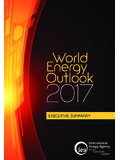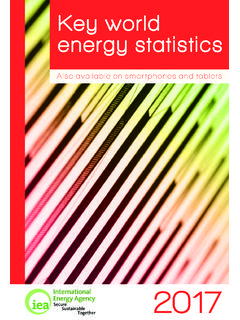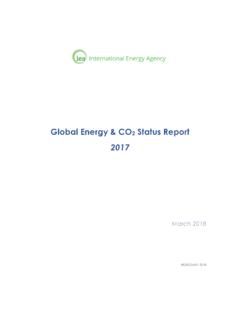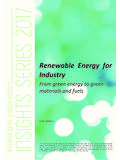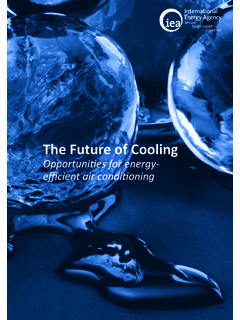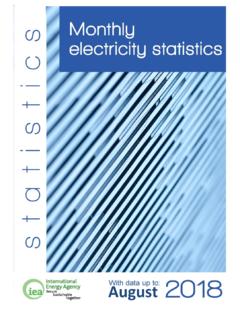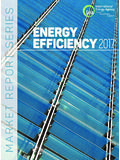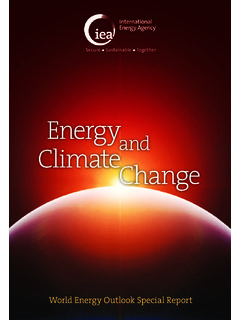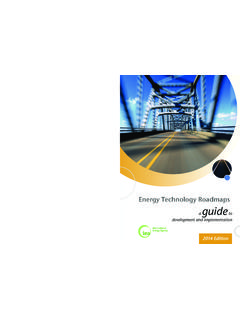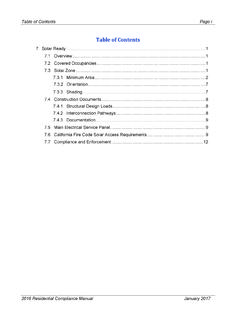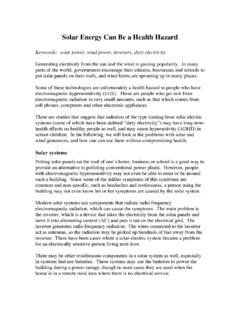Transcription of http://www.iea.org/publications/freepublications/publication/TechnologyRoadmapSolarPhotovoltaicEnergy_2014edition.pdf
1 2050. 2045. Ene es tiv 2040. rg 2035 Te ec p y chn rs olo g y P e Technology Roadmap Solar Photovoltaic Energy 2014 edition Secure Sustainable Together INTERNATIONAL ENERGY AGENCY. The International Energy Agency (IEA), an autonomous agency, was established in November 1974. Its primary mandate was and is two-fold: to promote energy security amongst its member countries through collective response to physical disruptions in oil supply, and provide authoritative research and analysis on ways to ensure reliable, affordable and clean energy for its 29 member countries and beyond. The IEA carries out a comprehensive programme of energy co-operation among its member countries, each of which is obliged to hold oil stocks equivalent to 90 days of its net imports.
2 The Agency's aims include the following objectives: n Secure member countries' access to reliable and ample supplies of all forms of energy; in particular, through maintaining effective emergency response capabilities in case of oil supply disruptions. n Promote sustainable energy policies that spur economic growth and environmental protection in a global context particularly in terms of reducing greenhouse-gas emissions that contribute to climate change. n Improve transparency of international markets through collection and analysis of energy data. n Support global collaboration on energy technology to secure future energy supplies and mitigate their environmental impact, including through improved energy efficiency and development and deployment of low-carbon technologies.
3 N Find solutions to global energy challenges through engagement and dialogue with non-member countries, industry, international organisations and other stakeholders. IEA member countries: Australia Austria Belgium Canada Czech Republic Denmark Estonia Finland France Germany Greece Hungary Ireland Italy Secure Sustainable Together Japan Korea (Republic of). Luxembourg Netherlands New Zealand Norway Poland Portugal Slovak Republic OECD/IEA, 2014 Spain International Energy Agency Sweden 9 rue de la F d ration 75739 Paris Cedex 15, France Switzerland Turkey United Kingdom Please note that this publication United States is subject to specific restrictions that limit its use and distribution. The European Commission The terms and conditions are available online at also participates in the work of the IEA.
4 Foreword Current trends in energy supply and use are deployment and falling costs have each been unsustainable economically, environmentally and driving the other. This progress, together with other socially. Without decisive action, energy-related important changes in the energy landscape, notably greenhouse-gas (GHG) emissions would lead to concerning the status and progress of nuclear power considerable climate degradation with an average and CCS, have led the IEA to reassess the role of 6 C global warming. We can and must change the solar PV in mitigating climate change. This updated path we are now on; sustainable and low-carbon roadmap envisions PV's share of global electricity energy technologies will play a crucial role in the rising up to 16% by 2050, compared with 11% in the energy revolution required to make this change 2010 roadmap.
5 Happen. Energy Efficiency, many types of renewable energy, carbon capture and storage (CCS), nuclear As PV spreads beyond Europe, where most power and new transport technologies will all deployment was concentrated until 2012, it faces a require widespread deployment if we are to achieve number of barriers, economic and non-economic. a global energy-related CO2 target in 2050 of 50% To help overcome such potential obstacles, this below current levels and limit global temperature updated roadmap provides renewed proposals rise by 2050 to 2 C above pre-industrial levels. on technology, system integration, legislative and regulatory issues, based on analyses of the lessons This will require significant global investment into learned by pioneering countries.
6 Decarbonisation, which will largely be offset by reduced expenditures on fuels. Nonetheless, this In mature PV markets currently still only a handful supposes an important reallocation of capital. To of countries greater market exposure is necessary address this challenge, the International Energy as PV becomes more competitive. However, Agency (IEA) is leading the development of a changes in legislative frameworks and support series of technology roadmaps which identify the policies must be as transparent and predictable steps needed to accelerate the implementation of as possible. Like most renewable energy sources technology changes. These roadmaps will enable and energy efficiency improvements, PV is very governments, industry and financial partners to capital-intensive: almost all expenditures are made make the right choices and in turn help societies up-front.
7 Keeping the cost of capital low is thus of to make the right decision. primary importance for achieving this roadmap's vision. But investment and finance are very Photovoltaic (PV) energy is one of the most responsive to the quality of policy making. Clear promising emerging technologies. The cost of PV and credible signals from policy makers lower risks modules has been divided by five in the last six and inspire confidence. By contrast, where there is years; the cost of full PV systems has been divided a record of policy incoherence, confusing signals or by almost three. The levelised cost of electricity of stop and go policy cycles, investors end up paying decentralised solar PV systems is approaching or more for their finance, consumers pay more for their falling below the variable portion of retail electricity energy, and some projects that are needed simply prices that system owners pay in some markets, will not go ahead.
8 Across residential and commercial segments. For bulk power on grid, PV electricity can already be I strongly hope that the analysis and competitive at times of peak demand, especially in recommendations in this roadmap will play a part areas where peak electricity is provided by burning in ensuring the continued success of PV deployment oil products. And there remains ample room for and, more broadly, a decarbonised energy system. improvements, as this roadmap details. This publication is produced under my authority as Much has happened since our 2010 IEA technology Executive Director of the IEA. roadmap for PV energy. PV has been deployed Maria van der Hoeven faster than anticipated and by 2020 will probably Executive Director reach twice the level previously expected.
9 Rapid International Energy Agency This publication reflects the views of the International Energy Agency (IEA) Secretariat but does not necessarily reflect those of individual IEA member countries. The IEA makes no representation or warranty, express or implied, in respect to the publication's contents (including its completeness or accuracy) and shall not be responsible for any use of, or reliance on, the publication. Foreword 1. Table of contents Foreword 1. Table of contents 2. Acknowledgements 4. Key findings and actions 5. Key actions in the next five years 6. Introduction 7. Rationale for solar photovoltaic power in the overall energy context 7. Purpose of the roadmap update 7. Roadmap process, content and structure 8.
10 Progress since 2009 9. Recent market developments 9. Technology improvements 11. Advances toward competitiveness 12. Barriers encountered, overcome or outstanding 16. Medium-term outlook 17. Vision for deployment 18. CO2 reduction targets from the ETP 2014 hi-Ren Scenario 18. Revised solar PV goals 20. Potential for cost reductions 22. Global investment to 2050 25. Beyond 2050 26. Solar PV technology development: Actions and milestones 27. Cells and modules 28. Non-module costs 30. Life-cycle analysis 31. System integration: Actions and milestones 32. Variability and uncertainty 32. System-friendly PV deployment 32. Integrating large PV shares 33. Decentralised PV generation 37. System level GHG emissions 39.
